Mar 22, 2009
History Made as Jones et al 2008 Paper Admits Huge Urban Warming in IPCC Flagship CRUT3 Gridded Data
By Warwick Hughes
So sceptics have been correct for decades.
Yes you have to pinch yourself, the old canard so long clung to by the IPCC, that the urban influence in large area gridded data is “an order of magnitude less than the warming seen on a century timescale” is now severely compromised.
The IPCC drew that conclusion from the Jones et al 1990 Letter to Nature which examined temperature data from regions in Eastern Australia, Western USSR and Eastern China, to conclude that “In none of the three regions studied is there any indication of significant urban influence.” That has led to the IPCC claim that for decades, urban warming is less than 0.05 per century.
Now Jones et al 2008 are saying in their Abstract, “Urban-related warming over China is shown to be about 0.1 degree per decade”, hey that equates to a degree per century. Huge. See Warwick’s post here.
As Alan Siddons notes “...a lot of post-correcting is called for now. Ths is what I get when I coordinate Hadley and GISS global temperatures with the MSU satellite record.”
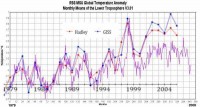
See larger image here See alternmative version courtesy of Junk Science here.
Icecap Note: The GISS US data which is UHI corrected using night lights shows a 0.75F difference (cooler) from the NOAA NCDC USHCN version 2 where UHI was removed.
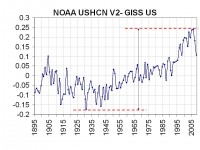
See larger image here.
This is equivalent to the 1F rate per century mentioned above. So, as we have been stating over and over again and I presented in NYC at the Heartland ICCC, MUCH OF THE LONG TERM TREND attributed to CO2 may be UHI induced errors in the global (and USHCN) data bases.
Mar 21, 2009
The Oceans Really Are Cooling
By Jennifer Marohasy
THERE are 3,000 free-drifting buoys in the world’s ocean; first deployed in the year 2000 they allow continuous monitoring of the temperature, salinity, and velocity of the upper ocean. There has though been some difficulty in interpreting the data from these buoys. Initial signs of cooling were dismissed as due to technical errors subsequently corrected based on a small sample of the 3,000 buoys known as profiling floats.
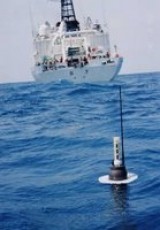
Craig Loehle has analysed the data from only the profiling floats for ocean heat content from 2003 to 2008. In a paper recently published in the journal Energy and Environment he has concluded that there has been ocean cooling over this period. This graphic is from figure 1 of the technical paper and shows the decline in ocean heat content (x1022J) smoothed with a 1-2-1 filter.
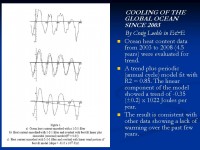
See larger image and abstract here.
Dr Loehle’s findings are consistent with satellite and surface instrumental records that do not showing a warming trend over recent years.
*************************
Notes:
Craig Loehle is a senior scientist at the Illinois-based ‘National Council for Air and Stream Improvement’. Cooling of the global ocean since 2003. Craig Loehle, 2009. Energy and Environment. Volume 20.
Argo (free-floating buoys) Homepage
Apologies to Josh Willis: Correcting Global Cooling (Part 3), NASA Changes Data to Fit the Models Adjusts Data from Buoys, Global Warming’s Missing Heat .
Mar 19, 2009
Reality Check: Shell Dumps Wind, Solar and Hydro Power
By Tim Webb, The Guardian. Hat Tip Dr. Benny Peiser CCNET
Shell will no longer invest in renewable technologies such as wind, solar and hydro power because they are not economic, the Anglo-Dutch oil company said today. It plans to invest more in biofuels which environmental groups blame for driving up food prices and deforestation.

Executives at its annual strategy presentation said Shell, already the world’s largest buyer and blender of crop-based biofuels, would also invest an unspecified amount in developing a new generation of biofuels which do not use food-based crops and are less harmful to the environment.
The company said it would concentrate on developing other cleaner ways of using fossil fuels, such as carbon capture and sequestration (CCS) technology. It hoped to use CCS to reduce emissions from Shell’s controversial and energy-intensive oil sands projects in northern Canada.
The company said that many alternative technologies did not offer attractive investment opportunities. Linda Cook, Shell’s executive director of gas and power, said: “If there aren’t investment opportunities which compete with other projects we won’t put money into it. We are businessmen and women. If there were renewables [which made money] we would put money into it.”
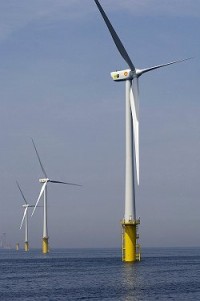
Shell said biofuels fitted its core business of providing fuels, logistics, trading and branding. Cook added: “It’s now looking like biofuels is one which is closest to what we do in Shell. Wind and solar are interesting [but] we may continue to struggle with other investment opportunities in the portfolio even with big subsidies in many markets. We do not expect material investment [in wind and solar] going forward.”
Until recently, Shell’s investment in wind power featured prominently in its corporate advertisements. FoE said the company’s move heralded a slightly more honest approach. “Shell is at least being a bit more honest about the fact they are a fossil fuel company. It has seen the limitations of the greenwash it was putting out a few years ago.” Read more here.
Mar 17, 2009
Blame Sunspots for Cool Winter, Spring Weather
By George Taylor, Democrat Herald.com
Brrrr! It’s been a cold week, in a cold month, in a cold winter. And it shows no sign of letting up. Last week the Northwest was gripped by unseasonably cold weather. Areas west of the Cascades saw temperatures dip into the 20s. Locally we dropped as low as 27 on the 13th. Eugene was even colder (24 on the 11th). Two days later, Eugene’s 25 degree-low broke the daily record (26) set in 1944. So far in March our local Hyslop Experiment Station has seen nine days with lows of 32 or below. The month of March averages 5.7 days, so we’re already well ahead of average for an entire March.
As cold as it was here, the Cascades generally protected us from the coldest Arctic air, which remained mostly north and east of us. On the 11th, Spokane, Wash., reported a low of 2 degrees. This was the latest date for a temperature of 2 degrees or less. The previous latest date occurred March 6, 1891. Sandpoint, Idaho, set a similar record the same day with a readi ng of -4 degrees, the latest date for a temperature that low.
Western Montana saw temperatures as low as -14, and subzero readings were reported in other states. In Oregon, many daily records were set, many far below the previous. Meacham was -11 on the 11th; the record for was 7, so this week’s weather broke the record by 18 degrees! LaGrande, Pendleton, Moro, The Dalles, Bend, Redmond, and others also set new records.
The cause of this cold month and cold year? Two things: the tropical Pacific and the sun. The tropical Pacific continues in its “La Nina” mode, in which ocean temperatures off South America are cooler than average. During such conditions, winters in the Northwest are cooler than average, wetter than average, or both. Snowpacks tend to be average or deeper. Thus far, we’ve had a cold but dry winter, with an average mountain snowpack.
The sun continues in its “solar minimum.” There is an 11-year cycle (about) in sunspots. When spots are plentiful, the sun’s energy is stronger, and there is a tendency for Earth’s temperatures to increase. During the low point there are few sunspots, and temperatures are more likely to drop. We have been in a solar minimum for more than a year. NASA and other agencies predicted that sunspot numbers would be increasing by now, but they are not. According to NASA, we are seeing:
- The lowest sustained solar radio flux since the F10.7 proxy was created in 1947;
- Solar wind is the lowest observed since the beginning of the space age;
- The solar wind magnetic field 36 percent weaker than during the minimum of Solar Cycle 23;
- Effectively no sunspots;
- Cosmic rays at near record-high levels.
These might make sense, but here’s what it means: The sun is quiet, and has been for an unusually long period. Looking back over the last several hundred years, we see that solar output has been high for the last 60 years; this coincided with a general increase in temperatures. There have been some periods with low sunspot counts for many years. The early 1700s and 1800s saw lengthy solar minima, accompanied by cold temperatures.
Some solar physicists are suggesting the minimum is a harbinger of lower sunspot numbers for the next several decades. That would mean lower air temperatures, in general - global cooling! Others suggest El Nino and La Nina conditions are driven by variations in the sun; periods with low solar output would bring La Nina conditions (such as now). We’ll see. But with a quiet sun and a continuing La Nina, I don’t expect temperatures to warm up much in the near future. Expect a cool spring, like last year.
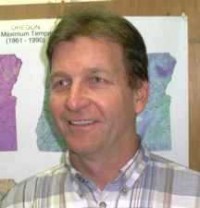
George Taylor retired as State Climatologist last year and now operates Applied Climate Services of Corvallis.
Mar 17, 2009
Michael Steele: ‘We Are Not Warming’
By Kate Galbraith, New York Times
Michael Steele, the chairman of the Republican National Committee, said we live on a cooling planet. The Republican National Committee Chairman, Michael Steele, has weighed in on climate change.
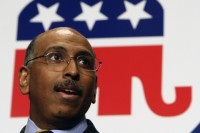
In a March 6 radio appearance that is only now percolating through the blogosphere, Mr. Steele apparently fielded a skeptic’s question about global warming. As transcribed by the liberal blog, the Huffington Post, Mr. Steele thanked the questioner and replied this way: We are cooling. We are not warming. The warming you see out there, the supposed warming, and I am using my finger quotation marks here, is part of the cooling process. Greenland, which is now covered in ice, it was once called Greenland for a reason, right? Iceland, which is now green. Oh I love this. Like we know what this planet is all about. How long have we been here? How long? No very long.
Mr. Steele - the originator of the “drill baby drill” slogan that dominated last year’s Republican National Convention - appears to be aligning himself with Republican Senator James Inhofe of Oklahoma, who has denounced the idea of a global warming catastrophe as “the greatest hoax ever perpetrated on the American people,” and said that many of the Obama administration’s early moves amount to “environmental thuggery.” Sen. John Boehner, the Senate minority leader, has described cap-and-trade as a “carbon tax that increases taxes on all Americans who drive a car, who have a job, who turn on a light switch.”
Many other Republicans argue that climate change is real and needs to be addressed. Sen. John McCain, the presidential nominee last year, is one of the original architects of a Congressional cap-and-trade bill, though he forcefully opposes the Obama administration’s plan to auction off emissions allowances to polluters (Mr. McCain would prefer to give the initial allowances away for free). John Huntsman, the Republican governor of Utah, also favors a cap-and-trade system for limiting carbon emissions, as mentioned in this New York Times profile. So does California governor Arnold Schwarzenegger.
In Washington, however, many say it is not Republicans, but the coal-state Democrats in the Senate, who will decide the fate of any cap-and-trade bill. Read more here.
|










